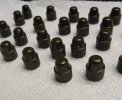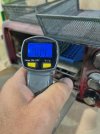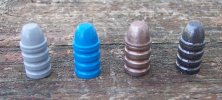Triboelectric effect -- friction resulting in the flow of electrons from one material to another!
The ability to retain that charge is determined by the material, in our case, lead and polyester. #5 container is decent, (PP), doesn't retain moisture and is durable. PVC can retain moisture. H2O is polar, captures electrons that 'kill' the process. Swirling powder gains charge and is attracted to the lead. Shaking gets the charged powder to float in the air where it settles on the bullets. ASBBs (IMHO) get charged and help to swirl the powder. Try swirling only powder - doesn't work well. I tried HF and Smoke's gloss black, didn't do well, results like the OPs.
As to time, make/buy lube sticks and lube sizer, vs shaking 2 min and another 10 to stand them up? Walk away and let them cook. No brainer! If they pass the smash test will shoot OK.
The ability to retain that charge is determined by the material, in our case, lead and polyester. #5 container is decent, (PP), doesn't retain moisture and is durable. PVC can retain moisture. H2O is polar, captures electrons that 'kill' the process. Swirling powder gains charge and is attracted to the lead. Shaking gets the charged powder to float in the air where it settles on the bullets. ASBBs (IMHO) get charged and help to swirl the powder. Try swirling only powder - doesn't work well. I tried HF and Smoke's gloss black, didn't do well, results like the OPs.
As to time, make/buy lube sticks and lube sizer, vs shaking 2 min and another 10 to stand them up? Walk away and let them cook. No brainer! If they pass the smash test will shoot OK.



